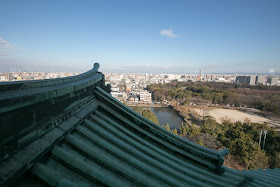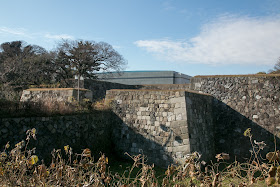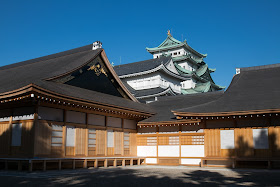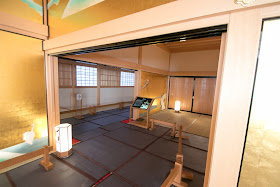Nagoya Castle (1)
-First residence of future ruler-
Overview
Name: Nagoya castle (Nagoya-jo)
Alias: Kinko-jo (Gold grampus castle)
Place: Honmaru Naka-ku Nagoya city, Aichi
Location: 35.1855411916887, 136.898325606063
Type: Flat castle
Built: Originally in 15th century, expanded in 1612
Remaining remnants: Turrets, gates, stone walls and moats
Title: 100 famous Japanese castles
Nagoya castle is located on the northwest edge of Nagoya height, at the central area of Nagoya city. Nagoya area places at the center of Nobi plain, a vast plain with high agricultural production.
Also Nagoya area prospered by sea transportation on Isewan gulf, and also an area of important communication which manages both of Tokaido road, a most important road connected Kyoto city and Eastern Japan, and Nakasendo road, a road to central mountainous area. These geographical condition grew three rulers united Japan, it mean Nobunaga Oda (1534-1582), Hideyoshi Toyotomi (1537-1598) and Ieyasu Tokugawa (1543-1616).
Historically the center of Owari country (western half of Aichi prefecture) had been the western part of Owari country. In Muromachi era, Shiba clan, a nominal governor of Owari province and Iwakura Oda clan, a deputy governor of upper half who resided at Iwakura castle (Iwakura city). On the other hand, Kiyosu Oda clan, the deputy governor of lower half of Owari province, lived at Kiyosu castle. Nobuhide Oda (1510-1551), the father of Nobunaga Oda, was one of three important retainers of this Kiyosu Oda clan and located at Shobata castle.
Nobuhide was only an indirect retainer of the governor, but based on the economic power generated from Tsushima port at his territory, Nobuhide gradually grew his power and lead other Oda clans in Owari province. But Nobuhide did not try to beat his masters, and instead advanced to eastward, current Nagoya city area. Nagoya height was undeveloped area at that time, but at the south edge of the height there was Atsuta Shrine, a traditional shrine of this area. Atsuta town prospered as an attached town of the shrine and also had a good port.
At the site of current Nagoya castle there was a small castle built by Imagawa clan. This Imagawa clan was a branch family of Imagawa clan which was the governor of Suruga province (middle part of Shizuoka prefecture). In 1532, Nobuhide deprived this Nagoya castle from Ujitoyo Imagawa (?-?). It is said that Nobuhide had a communication of poem (Renga, traditional Japanese culture) with Ujitoyo and made him loose, then pretend to have hunting near the castle and intruded. Nobuhide further built Furuwatari castle and Suemori castle at the south and east of Nagoya castle, to secure Nagora area.
Nobuhide placed his son Nobunaga Oda as a commander of Nagoya castle. Nobunaga was the second son of Nobuhide, but as being born from formal wife, Nobunaga was planned to succeed Nobuhide. Nobunaga grew his childhood at Nagoya castle, but his behavior was strange and different from child of other lords.
According to "Shincho Koki", a trustable biography of Nobunaga, Nobunaga hated normal dress and wear loose but flamboyant cloths. Nobunaga made party with his companions and wandered around the town, and ate fruits or rice cakes among the people. Due to this behavior Nobunaga was accused as fool, but by this behavior Nobunaga grew his future loyal direct force, and also the habit that gather important information by himself.
Nobuhide fiercely fought with Dosan Saito (1494-1556), an uplifted governor of Mino country (Gifu prefecture) or Yoshimoto Imagawa (1519-1560), the warlord of Suruga country and Totomi province (Shizuoka prefecture). Nobuhide fought well against both clan and once deprived Ogaki castle at Mino country and Anjyo castle at Mikawa country. But two front war was severe for Nobuhide, then Nobuhide was defeated by Saito clan and Imagawa clan, and lost Ogaki castle and Anjo castle.
To settle the situation, Nobuhide decided to make peace with Dosan Saito, and Nobunaga married with Princess Nohime, a daughter of Dosan (1535-?) in 1549. This was a solely political marriage, and there is quite limited record for this formal wife of Nobunaga. It is said that Nohime was sent back to Mino country when Dowan was killed by his son Yoshitatsu Saito (1527-1561) and both clan broke up, and died at Mino country.
Some story says Nohime lived with Nobunaga and died at the incident of Honnoji in 1582, in which Nobunaga killed himself by a coup d'etat of his general Mitsuhide Akechi (1528-1582) but another says Nohime survived after the incident. It is said that Nohime and Mitsuhide Akechi was relative, and this attracts imagination of writers. Anyway all son of Nobunaga were born from concubine of Nobunaga.
In 1551, Nobuhide died in ill and Nobunaga succeed his position. It is said that Nobunaga spread incense at the funeral celemony of Nobuhide. Other Oda clan only followed to the wealth of Nobuhide left Nobunaga, and important retainers of Nobunaga such as Michikatsu Hayashi (?-1580) or Katsuie Shibata (1522-1583) supported Nobunaga's younger brother Nobukatsu Oda (1536-1557). But Nobunaga patiently fought with external and internal enemies in severe situation.
In 1554, Kiyosu Oda clan made revolt to nominal governor Shiba clan and killed the leader of Shiba clan. Nobunaga promptly attacked Kiyosu Oda clan along with his uncle Nobumitsu Oda (1516-1556), as a revenge of the governor. Kiyosu Oda clan was extinguished and Nobunaga captured Kiyosu castle, then Nobunaga moved to Kiyosu castle and leave Nagoya castle to Nobumitsu. But Nobumitsu died just after this incident, and it is said that Nobunaga assassinated Nobumitsu to erase his substantial rival.
In 1557, Nobukatsu revolted to Nobunaga along with Michikatsu Hayashi and Katsuie Shibata, but Nobunaga broke him at the battle of Inou and forced him to surrender. Next year Nobunaga assassinated Nobukatsu who planned another revolt, and finally in 1559 Nobunaga expelled Iwakura Oda clan and united Owari province again. Next year Nobunaga defeated Yoshimoto Imagawa who invaded with large army to Owari province at the battle of Okehazama, and now the basis of Nobunaga has stabilized. Now Nobunaga became a strong warlord held whole Owari province, and started his movement to the ruler.
The detail of Nagoya castle at this time is unclear because it was totally destructed by the construction of current Nagoya castle, but it is said to locate at secondary area of current Nagoya castle. Considering the structure of other castles of Owari country around the same time, this castle consist of two layer of square area guarded by clay walls and water moats. After the death of Nobumitsu Oda, Nobunaga placed Michikatsu Hayashi at this castle, but finally this Nagoya castle was abolished around 1582.
Continue to Part 2
Type: Flat castle
Built: Originally in 15th century, expanded in 1612
Remaining remnants: Turrets, gates, stone walls and moats
Title: 100 famous Japanese castles
Brief History
Nagoya castle is located on the northwest edge of Nagoya height, at the central area of Nagoya city. Nagoya area places at the center of Nobi plain, a vast plain with high agricultural production.
Also Nagoya area prospered by sea transportation on Isewan gulf, and also an area of important communication which manages both of Tokaido road, a most important road connected Kyoto city and Eastern Japan, and Nakasendo road, a road to central mountainous area. These geographical condition grew three rulers united Japan, it mean Nobunaga Oda (1534-1582), Hideyoshi Toyotomi (1537-1598) and Ieyasu Tokugawa (1543-1616).
Growth of Nobuhide Oda
Historically the center of Owari country (western half of Aichi prefecture) had been the western part of Owari country. In Muromachi era, Shiba clan, a nominal governor of Owari province and Iwakura Oda clan, a deputy governor of upper half who resided at Iwakura castle (Iwakura city). On the other hand, Kiyosu Oda clan, the deputy governor of lower half of Owari province, lived at Kiyosu castle. Nobuhide Oda (1510-1551), the father of Nobunaga Oda, was one of three important retainers of this Kiyosu Oda clan and located at Shobata castle.
Nobuhide was only an indirect retainer of the governor, but based on the economic power generated from Tsushima port at his territory, Nobuhide gradually grew his power and lead other Oda clans in Owari province. But Nobuhide did not try to beat his masters, and instead advanced to eastward, current Nagoya city area. Nagoya height was undeveloped area at that time, but at the south edge of the height there was Atsuta Shrine, a traditional shrine of this area. Atsuta town prospered as an attached town of the shrine and also had a good port.
At the site of current Nagoya castle there was a small castle built by Imagawa clan. This Imagawa clan was a branch family of Imagawa clan which was the governor of Suruga province (middle part of Shizuoka prefecture). In 1532, Nobuhide deprived this Nagoya castle from Ujitoyo Imagawa (?-?). It is said that Nobuhide had a communication of poem (Renga, traditional Japanese culture) with Ujitoyo and made him loose, then pretend to have hunting near the castle and intruded. Nobuhide further built Furuwatari castle and Suemori castle at the south and east of Nagoya castle, to secure Nagora area.
First residence of future ruler
Nobuhide placed his son Nobunaga Oda as a commander of Nagoya castle. Nobunaga was the second son of Nobuhide, but as being born from formal wife, Nobunaga was planned to succeed Nobuhide. Nobunaga grew his childhood at Nagoya castle, but his behavior was strange and different from child of other lords.
According to "Shincho Koki", a trustable biography of Nobunaga, Nobunaga hated normal dress and wear loose but flamboyant cloths. Nobunaga made party with his companions and wandered around the town, and ate fruits or rice cakes among the people. Due to this behavior Nobunaga was accused as fool, but by this behavior Nobunaga grew his future loyal direct force, and also the habit that gather important information by himself.
Nobuhide fiercely fought with Dosan Saito (1494-1556), an uplifted governor of Mino country (Gifu prefecture) or Yoshimoto Imagawa (1519-1560), the warlord of Suruga country and Totomi province (Shizuoka prefecture). Nobuhide fought well against both clan and once deprived Ogaki castle at Mino country and Anjyo castle at Mikawa country. But two front war was severe for Nobuhide, then Nobuhide was defeated by Saito clan and Imagawa clan, and lost Ogaki castle and Anjo castle.
Political marriage
To settle the situation, Nobuhide decided to make peace with Dosan Saito, and Nobunaga married with Princess Nohime, a daughter of Dosan (1535-?) in 1549. This was a solely political marriage, and there is quite limited record for this formal wife of Nobunaga. It is said that Nohime was sent back to Mino country when Dowan was killed by his son Yoshitatsu Saito (1527-1561) and both clan broke up, and died at Mino country.
Some story says Nohime lived with Nobunaga and died at the incident of Honnoji in 1582, in which Nobunaga killed himself by a coup d'etat of his general Mitsuhide Akechi (1528-1582) but another says Nohime survived after the incident. It is said that Nohime and Mitsuhide Akechi was relative, and this attracts imagination of writers. Anyway all son of Nobunaga were born from concubine of Nobunaga.
Struggle and unite of Owari country
In 1551, Nobuhide died in ill and Nobunaga succeed his position. It is said that Nobunaga spread incense at the funeral celemony of Nobuhide. Other Oda clan only followed to the wealth of Nobuhide left Nobunaga, and important retainers of Nobunaga such as Michikatsu Hayashi (?-1580) or Katsuie Shibata (1522-1583) supported Nobunaga's younger brother Nobukatsu Oda (1536-1557). But Nobunaga patiently fought with external and internal enemies in severe situation.
In 1554, Kiyosu Oda clan made revolt to nominal governor Shiba clan and killed the leader of Shiba clan. Nobunaga promptly attacked Kiyosu Oda clan along with his uncle Nobumitsu Oda (1516-1556), as a revenge of the governor. Kiyosu Oda clan was extinguished and Nobunaga captured Kiyosu castle, then Nobunaga moved to Kiyosu castle and leave Nagoya castle to Nobumitsu. But Nobumitsu died just after this incident, and it is said that Nobunaga assassinated Nobumitsu to erase his substantial rival.
In 1557, Nobukatsu revolted to Nobunaga along with Michikatsu Hayashi and Katsuie Shibata, but Nobunaga broke him at the battle of Inou and forced him to surrender. Next year Nobunaga assassinated Nobukatsu who planned another revolt, and finally in 1559 Nobunaga expelled Iwakura Oda clan and united Owari province again. Next year Nobunaga defeated Yoshimoto Imagawa who invaded with large army to Owari province at the battle of Okehazama, and now the basis of Nobunaga has stabilized. Now Nobunaga became a strong warlord held whole Owari province, and started his movement to the ruler.
Structure and afterward of old Nagoya castle
The detail of Nagoya castle at this time is unclear because it was totally destructed by the construction of current Nagoya castle, but it is said to locate at secondary area of current Nagoya castle. Considering the structure of other castles of Owari country around the same time, this castle consist of two layer of square area guarded by clay walls and water moats. After the death of Nobumitsu Oda, Nobunaga placed Michikatsu Hayashi at this castle, but finally this Nagoya castle was abolished around 1582.






































































































































































































































































































































No comments:
Post a Comment